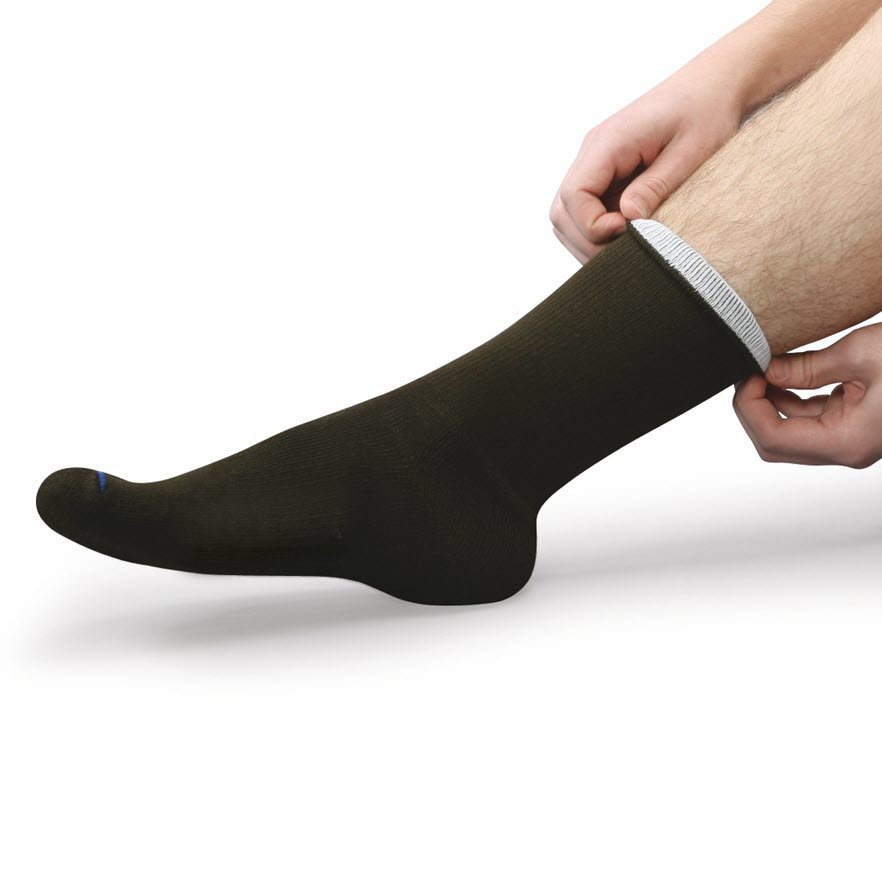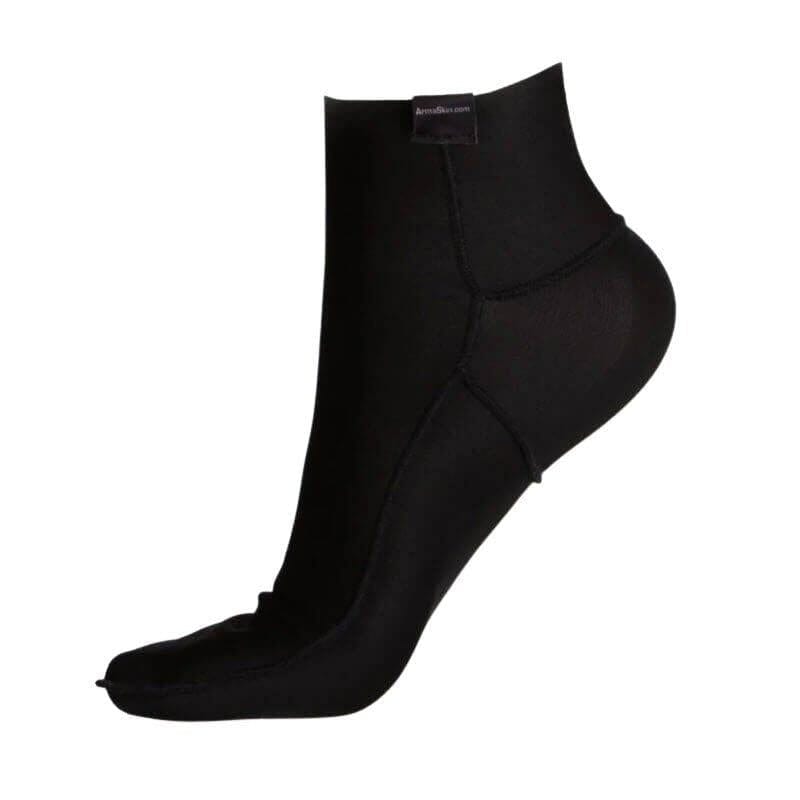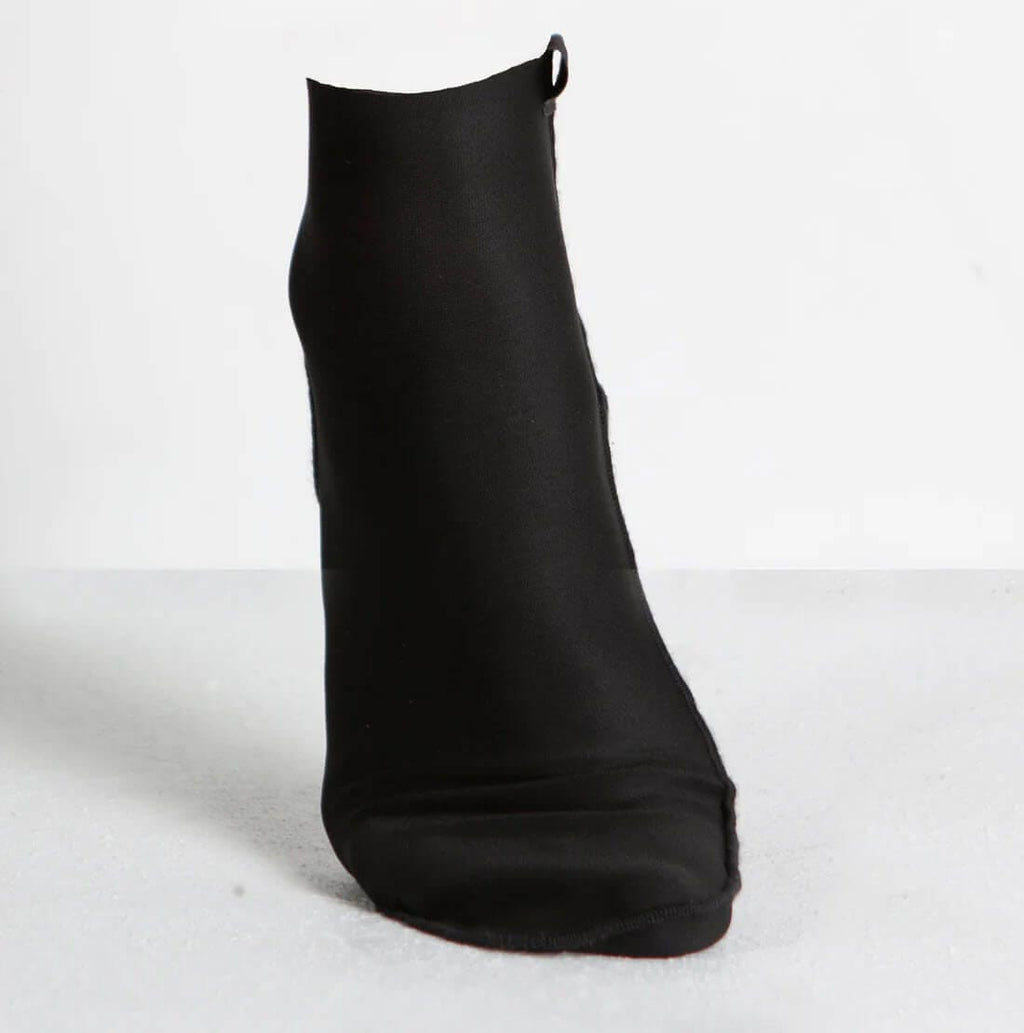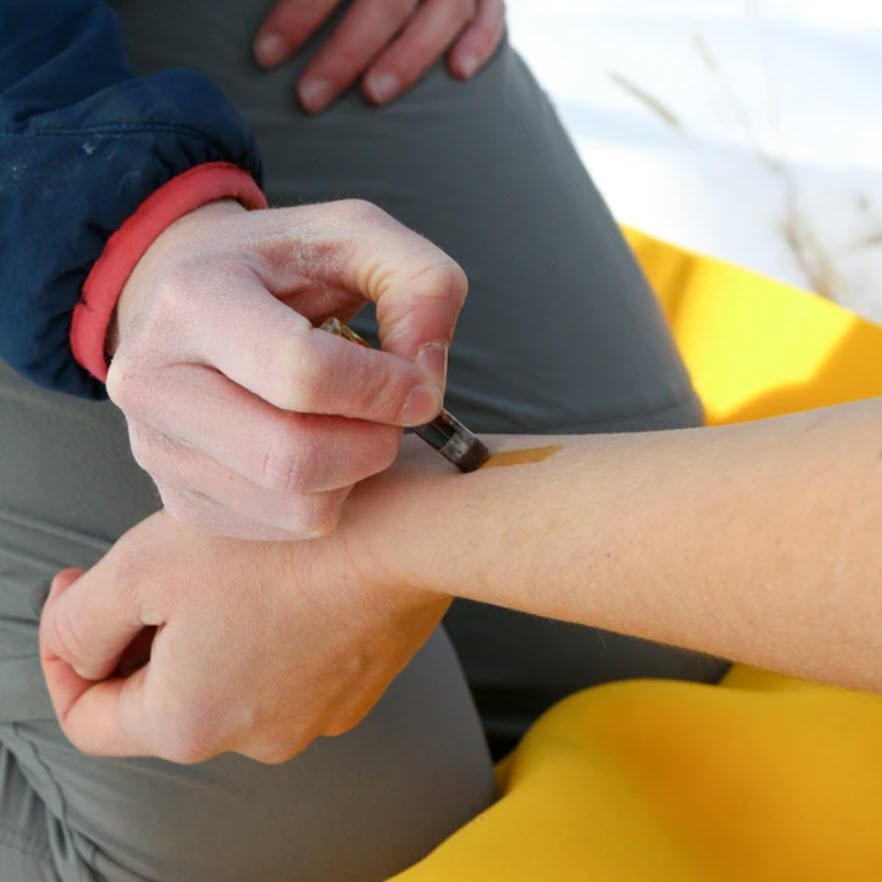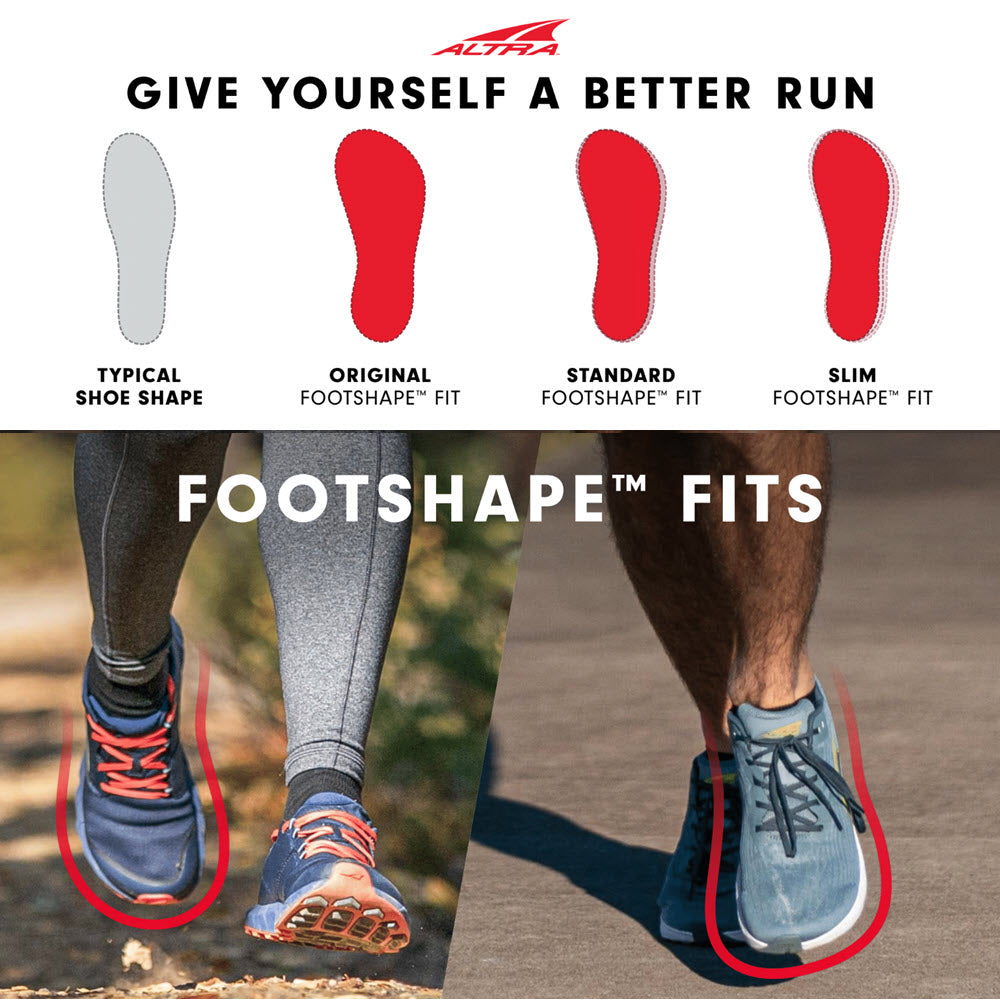No doubt you've heard of double socks or double-layer socks. In this article, we’ll answer:
- What they are and who uses double socks
- The different types and some brands
- How they work and the research on blisters
There are 2 types of double sock systems
- Literally wearing 2 pairs of socks
- Socks that have two layers at certain locations within the sock (double-layer socks)
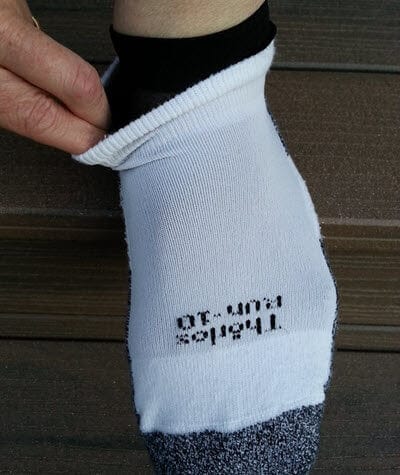
Double socks: Wearing two different socks, one over the other
To understand how double socks work, you need to know about material interfaces
An interface is where two surfaces meet. When wearing shoes & socks there are two interfaces:
- Skin-sock interface (black line)
- Sock-shoe interface (blue line)
Each interface has a certain level of friction. This measurement is called the coefficient of friction (COF) which is a number usually less than 1.0. In the shoe, friction levels generally range from 0.40 - 0.90 (Carlson, 2009). When blisters are a problem, there is high friction at both of the interfaces. One way to prevent blisters is to reduce the COF at one of these interfaces. Examples would be:
- Lubricants, powders, antiperspirants: at the skin-sock interface (black line)
- ENGO Blister Patches: at the shoe-sock interface (blue line)
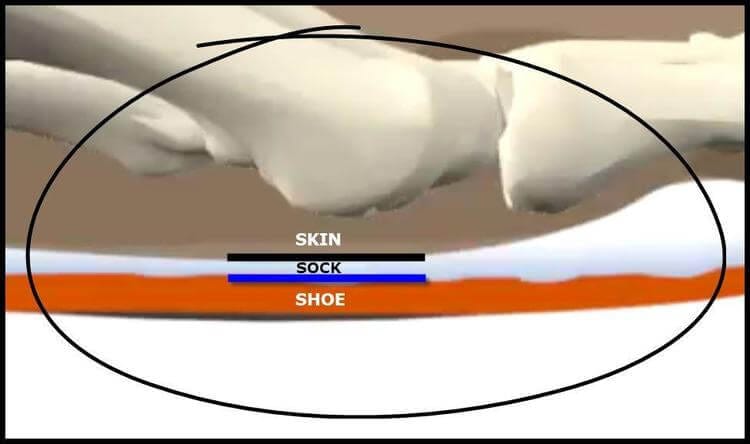
There are two material interfaces when wearing a single pair of socks (skin/sock and sock/shoe)
Double-socks introduce a third interface
You can create an extra interface by wearing another pair of socks. This creates a sock-sock interface. If the sock-sock interface COF is lower than that of the other two interfaces, the two socks will slide across one another before the others do. That will reduce the magnitude of blister-causing shear distortions.
Double sock research
Double layer sock systems are a COF reduction strategy and are used to create an additional material interface. The intention is for the sock-sock interface to exhibit a lower COF compared to both the skin-sock and shoe-sock interfaces so slippage occurs sooner between the two sock layers. There has been considerable interest from various military organizations in studying how these sock systems can prevent friction blisters on the feet of marching soldiers.
Study 1
Knapik and colleagues [1] studied blister incidence and severity in 357 marine recruits wearing either standard issue socks or one of two double sock systems: a standard issue sock plus a thin polyester inner sock, or a very thick, dense, wool-polypropylene prototype outer sock over the thin polyester inner sock. The standard issue sock was described as a one twist per inch sock, thicker at the heel and sole where the fabric composition is 50% wool, 50% cotton with spandex, with the remainder of the sock 50% wool, 30% cotton and 20% nylon. The prototype sock was described as a uniformly thick 50% wool, 50% polypropylene sock with a thread density of seven twists per inch. The authors provided no further description of the white polyester liner sock other than describing it as thin. Blister incidence for each group was:
- 69% (standard)
- 77% (standard + inner sock)
- 40% (prototype + inner sock)✅
Severe blisters requiring medical attention:
- 24% (standard)
- 9% (standard plus inner sock) ✅
- 11% (prototype plus inner sock)
This study showed that the double sock systems were somewhat more protective of blisters than a single sock. The standard issue sock plus liner reduced blister severity, but the dense prototype wool sock combined with a polyester liner reduced both overall blister incidence and blister severity.
Study 2
Jagoda and colleagues [2] compared blister incidence and severity on a group of 221 male lieutenants on their first training hike using one of three sock/powder conditions:
- 59% (standard issue sock only)*
- 41% (white athletic sock + nylon sock + powder)
- 22% (standard issue sock + white athletic sock + powder) ✅
*Blister severity was highest in the standard issue sock only.
This study showed that the double sock systems were more protective of blisters, and severe blisters, compared to a single sock. However, the results are complicated with the use of powder with the double socks.
Study 3
Van Tiggelen and colleagues [3] looked at the effect of different socks systems on 189 Belgian military recruits undergoing basic military training.
- The control group wore the standard issue military sock (70% combing wool and 30% polyamide) [SINGLE SOCK]
- A second group wore padded polyester socks (88% polyester, 11% polyamide, and 1% elastane) [SINGLE SOCK]
- The third group wore a double-sock combination of a thin inner sock (45% polyester, 45% viscose, 8% polyamide, and 2% elastane) under a thick cotton–wool sock (40% cotton, 40% wool, 18% polyamide, and 2% elastane) [DOUBLE SOCK]
Blister incidence was:
- 51% (control single sock)
- 16% (padded polyester single sock) ✅
- 32.3% (double sock)
The single padded polyester sock provided greater blister protection than the double-layer sock system.

Interpretation of these 3 studies
The results are equivocal. The material composition and thickness of the two socks likely affects the outcome, and varied considerably in the 3 pieces of research. More investigation is required before we can confidently recommend one double sock system over another.
My understanding is the ideal sock combination is a close-fitting thin hydrophobic (water-repelling) inner sock, with a thicker moisture-wicking outer sock that maintains its bulk in spite of moisture.
ArmaSkin double socks
Lacking research to demonstrate blister protection is a relatively new double sock system called ArmaSkin. This system consists of the specialised ArmaSkin inner sock, while the user self-selects an outer sock. The unique aspect of this inner sock is its skin-side is a silicone material that creates a very high friction coefficient against the skin and comparatively low friction interface between the two socks.
Toesocks
Toe-socks such as Injinji and Creepers can be thought of as a form of double sock system for interdigital areas and may theoretically reduce the incidence of interdigital blisters. That is assuming the COF remains sufficiently low. This sock-sock interface is actually the same material, whereas the principal of double sock systems is to use the effect of different sock materials or construction for friction reducing properties. However, blister incidence may be reduced as a result of the increased bulk between the toes acting as cushioning to reduce pressure peaks.
To date, the effectiveness of toe socks has not been established. However, while testing the effectiveness of paper tape on all toes on the experimental foot, Lipman and colleagues [4] found that the simultaneous use of Injinji (Injinji Inc) toe socks was associated with an increased blister occurrence. Specifically, 34% of feet that were taped and wore toe socks sustained blisters, whereas 27% did not incur blisters. They did not explicitly state that these blisters occurred on the toes and did not comment on an increased blister incidence with the simultaneous use of paper tape and toe socks in the follow-up study 2 years later [5]. Overall, toe socks have not been adequately tested to enable any conclusions to be drawn.
Three commercially available double socks (and my own experiences)
WrightSock:
WrightSock make socks with two layers built in to them. Every time I put them on, the inner sock tends to fold over on itself in a couple of places, enough to think that it's going to cause a problem. But that doesn't last long and has never been an issue while I'm walking or running. My foot seems to move around too much in the beginning as the two layers easily glide over one another. But again, this doesn't last long - presumably a bit of sweat increases friction levels enough to lessen the relative movement. The ones I've used have the fibre content below.
- Lightweight: InnerLayer (70% Polyester 30% Nylon); OuterLayer (68% Polyester 28% Nylon 4% Lycra)
- Midweight: InnerLayer (70% Polyester 26% Nylon 4% Lycra); OuterLayer (68% Polyester 24% Nylon 8% Lycra)
 WrightSocks double socks (image credit: mylifeoutdoors.com)
WrightSocks double socks (image credit: mylifeoutdoors.com)
Fortisocks (no longer in production):
A one size fits all thin short tubular sock designed to be the inner sock layer. Although they no longer sell these, you get the same effect with a pair of ladies nylon knee-high stockings cut shorter and worn under your standard sock.
ArmaSkin:
Also an inner sock layer, the ArmaSkin sock is different to other double sock inners I've seen. They feel very unusual because the sock sticks to you. I'm sure that's because of the silicone content - silicone has a high friction level. Their fibre content is 87% polyester 16% Spandex 5% silicone.You don't pull these on like normal socks - they don't slide against the skin. You need to "roll" them on. Although I got the smallest size (Ladies 2-8) they were a bit big and the heel doesn't contour exactly right. It didn't really both me though. And the big bulky seams surprisingly didn't bother me (except the one under my heel that ordinarily wouldn't have been there if you had the right sized foot).
I am left wondering how the silicone inner side deals with sweat. I've heard of variable levels of satisfaction from runners and bushwalkers. Ultra168 had a few readers trial them to get feedback - worth a read. As did The Bushwalking Blog here.
Knowing what I know about interfaces, ArmaSkin socks work by creating an artificially high skin-sock friction level, so the sock grips to the skin, all but guaranteeing the sock-sock friction level is lower. The manufacturers are yet to test the friction properties of the ArmaSkin sock (no sock manufacturer has to my knowledge). I’d love to know as I’m sure these have a really low friction level. And I'm pretty sure ArmaSkin socks do the best job at reducing friction levels and preventing blisters compared to the others.
Double Socks or Not Really?
I have heard of socks being referred to as double socks but which in my opinion aren't. They consist of different materials on the inner compared to the outer side of the sock, most likely serving a moisture-wicking function as decsribed earlier. However, the layers are not separated. Here's a discussion about it amongst bushwalkers. The way double socks work is by having the two sock layers moving relative to each other so they must be separate layers.
Who's wearing double socks?
My informal conversations with blister-sufferers and athletic / adventure footwear retailers indicates it is a method used more by hikers than it is runners and other athletes. Double-socking is talked about a lot on various forums as the concept is well known. I’m not sure it is used widely though, but it’s hard to tell for sure. There are many that do double-sock and get the blister prevention results they need. Others presumably don't an move on to something else.
A final thought
Assuming a double sock system reduces friction significantly, it does so all over the foot. This global approach to friction management is not without its potential problems. My own thought is, assuming vigorous or long-lasting exercise, this effect will soon be over-ridden due to perspiration such that higher friction exists at this interface. At that point, whether the friction level remains low enough to maintain blister-free low-friction conditions will depend on the individual. Armaskin are your best bet. But if you continue to get blisters, an additional strategy will be required.
References
- Knapik JJ, Hamlet MP, Thompson KJ, Jones BH. Influence of boot-sock systems on frequency and severity of foot blisters. Mil Med. 1996; 161 (10): 594–598. doi:10.1093/milmed/161.10.594
- Jagoda A, Madden H, Hinson CA. A friction blister prevention study in a population of Marines. Mil Med. 1981; 146 (1): 42–44. doi.org/10.1093/milmed/146.1.42
- Van Tiggelen D, Wickes S, Coorevits P, Dumalin M, Witvrouw E. Sock systems to prevent foot blisters and the impact on overuse injuries of the knee joint. Mil Med. 2009; 174 (2): 183–189. doi:10.7205/milmed-d-01-8508
- Lipman GS, Ellis MA, Lewis EJ, et al. A prospective randomized blister prevention trial assessing paper tape in endurance distances (Pre-TAPED). Wilderness Environ Med. 2014; 25 (4): 457–461. doi:10.1016/j.wem.2014.06.013
- Lipman GS, Sharp LJ, Christensen M, et al. Paper tape prevents foot blisters: a randomized prevention trial assessing paper tape in endurance distances II (Pre-TAPED II). Clin J Sport Med. 2016; 26 (5): 362–368. doi:10.1097/JSM.0000000000000319
